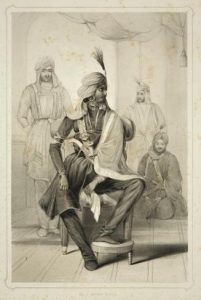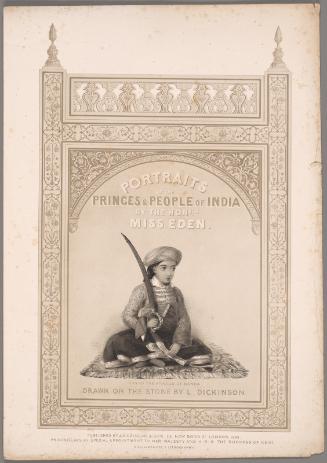SASI acquires a rare edition of Emily Eden’s Portraits of Princes and People of India
On May 20th, 2024, the South Asian Studies Institute received a rare copy of Portraits of Princes and People of India by Emily Eden (1797-1869). This book was originally gifted to a former BC Government leader from foreign dignitaries. As BC officials are not able to accept gifts, through the connection of the Royal BC Museum, the book now finds a home at the South Asian Studies Institute where researchers and community members will be able to access it.
Published in London in 1844, the book contains a collection of Emily Eden’s 28 sketches lithographed on 24 pages. Born and raised in England, Eden lived in colonial India under the British Raj from 1835-1842 where she drew these sketches. She had travelled to India with her sister Fanny where her brother George Eden, 1st Earl of Auckland was in residence as the Governor General. Emily lived in Shimla for stretches of time, which incidentally is the home city of our Director at SASI – Dr. Satwinder Bains who she studied at Auckland House School (est. later in 1866), the home of Emily Eden’s brother, commonly referred to as Lord Auckland. In her memoirs, Emily wrote of the Auckland House thus, “The views are too lovely, deep valleys on the drawing room side. Red rhododendron trees bloom in every direction and there are beautiful shrubberies on all sides of the hill.”
Most of Emily Eden’s sketches are portraits of prominent Sikh rulers, while others portray remarkable figures of fakeers (religious devotees), jemadars (headmen), Akalis (Sikh religious devotees/ soldiers), horseman, dwarfs, Shitr Sawar (camel riders carrying dispatches), Tartar traders from Tibet, wrestlers, and Zamindars (landowners) of that era.
The archival and collector value of this book can only be realized by its claim to carry the only surviving live portrait of Maharaja Ranjit Singh (1799-1839), the great ruler of undivided Punjab.

Alongside this historic sketch, the book also contains some rare portraits of Maharaja Ranjit Singh’s family and court members including Sher Singh (1807-1843), Kharrak Singh (1801-1840), and Heera Singh (1816-1844).

Portrait of Heera Singh, the Prime Minister of Lahore during Ranjit Singh’s reign. Heera Mandi in Lahore was named after him.
Outside of Ranjit Singh’s famed court, the book also portrays Chiefs of other princely states like Patiala, the Hill states, Nahun/ Nahan, and Oudh/Awadh.
Below is the list of sketches included in the book:
Frontispiece: The son of the Nawab of Banda
1. Dost Muhammad Khan, the ruler of Afghanistan, with one of his sons and a cousin
2. Maharajah Sher Singh, then ruler of the Punjab
3. A Hindu Fakir
4. A Head Servant of Government House, Calcutta
5. Akalis, or Sikh warriors
6. The Rajah of Patiala on his state elephant
7. Rajah Hira Singh
8. Maharajah Hindu Rao, a Mahratha Prince
9. One of the guards of the Rajah of Patiala with two dwarf servants
10. A young hill Rajah at Shimla
11. Dogs and Hawks, gifts from the King of Awadh to the Governor-General, with their attendants
12. Attendants of Rajah Kharak Singh
13. Maharajah Ranjit Singh
14. The favourite horse of Ranjit Singh with its groom; Emeralds and diamonds belonging to Ranjit Singh
15. Hunting leopards belonging to the King of Awadh with their attendants
16. Two of Alexander Burnes’ Arab servants
17. A Fakir attached to the Governor-General’s suite
18. A Student at the Hindu College in Calcutta; The daughter of one of the servants at Government House
19. Purtab Singh
20. A Camel despatch rider
21. The Rajah of Nahun and his sons; Anand Mussih, a Christian convert
22. A Group of Tibetan traders sketched at Shimla
23. A landowner and a Pathan
24. Lord Auckland receiving the Rajah of Nahun in Durbar.
At SASI we are honored and fortunate to be able to preserve this historically rich, and rare archival record at our Institute. We will upload a digital copy of this book on our SACDA website soon which will be immensely useful for future research on South Asian, and for those interested in Punjabi histories.

